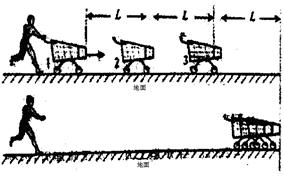问题
计算题
如图所示,静置于水平地面的三辆手推车沿一直线排列,质量均为m,人在极短的时间内给第一辆车一水平冲量使其运动,当车运动了距离L时与第二辆车相碰,两车以共同速度继续运动了距离L时与第三车相碰,三车以共同速度又运动了距离L时停止。车运动时受到的摩擦阻力恒为车所受重力的k倍,重力加速度为g,若车与车之间仅在碰撞时发生相互作用,碰撞时间很短,忽略空气阻力,求:

(1)整个过程中摩擦阻力所做的总功;
(2)人给第一辆车水平冲量的大小;
答案
(1) (2)
(2)
题目分析:(1)
(2) ,
,  ,
, 
 ,
, ,
,
 ,
, ,
, 

点评:本题关键在于运动的过程较多,有三个匀减速过程和两个碰撞过程,可以交叉运用动能定理和动量守恒定律列式求解,题中涉及的字母较多,要有足够的耐心,更要细心!
